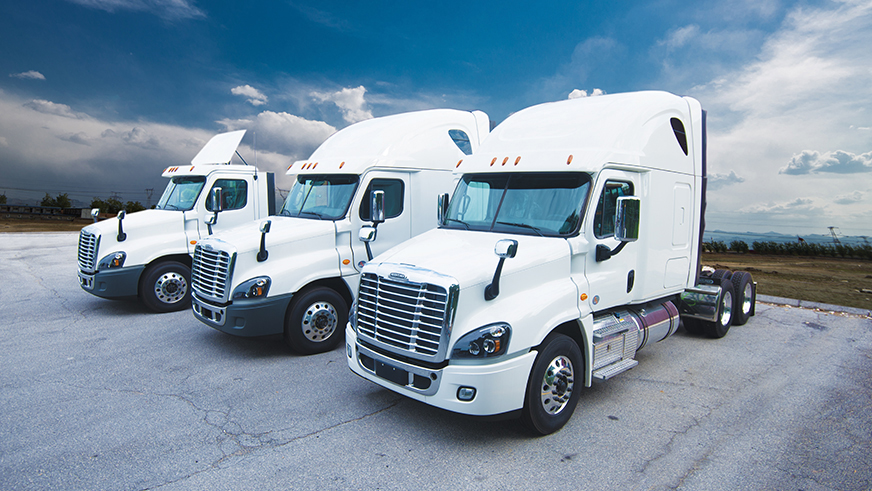What Is Fleet Management?
Fleet management is a discipline that focuses on optimizing the whole lifecycle of your fleet, from financing and leasing to maintenance, compliance, vehicle tracking, driver management, and more.
Fleet management helps you reduce costs across the board, lowers the chances of accidents and breakdowns, helps you to buy and sell vehicles at the optimal times, and more.
Fleet management systems (FMS)
Fleet management systems (FMS) are used for tracking and maintaining vehicle fleets in a company. They also help companies monitor driver safety and uphold legal regulations such as the ELD (Electronic Logging Device) Mandate.
They use GPS tracking and sensors to monitor how vehicles are being driven. That includes tracking the real-time location of the trucks, monitoring their fuel levels, speeds, sudden breakage, engine fault codes, and more.
For some fleets, an ELD-compliant hardware tracking system that integrates with the engine to track hours of service (HOS) is required by law.
What Is Involved in Fleet Management?
Fleet management starts with the financing of and purchase of a vehicle and ends with remarketing or reselling. It includes everything in between as well, from fleet maintenance and compliance to tracking vehicle and driver performance.
To truly understand what it involves, a surface-level view is not enough. Let’s take a closer look at the different elements of fleet management.
Vehicle acquisition
A fleet manager must not only locate suitable vehicles (based on capacity, refrigeration, mobility, etc.), but negotiate the right price and finance the purchases or leases in line with the company’s budget.
Vehicle maintenance
Likewise, a manager should leverage the company’s position (having a large number of cars, trucks, or vans), to negotiate beneficial maintenance deals. They must also develop a maintenance plan or program to ensure that there is minimal downtime or accidents.
Monitoring data on vehicle usage like sudden breakage and engine fault codes can help guide maintenance decisions. Keeping a roadworthy fleet is essential.
Driver safety and compliance
Maintaining fleet safety is a crucial responsibility for trucking companies. They must ensure that their drivers follow the regulations, and drive safely, through implementing an ELD, dashcam systems, or other measures.
Fleet tracking and monitoring
Most FMS providers use dedicated telematics devices to track location by GPS and monitor the condition of each vehicle — checking RPM, fuel consumption, and engine fault codes.
With smartphones and mobile apps for fleet management, it’s possible to implement GPS-tracking of all your drivers and vehicles at scale without extra hardware.
OptimoRoute tracks driver location via our mobile app, so you can view the real-time position of individual vehicles or your entire fleet.
Driver retention
Keeping your drivers employed for the long term is more important than ever. There was a truck driver deficit of over 60,800 in 2018, and it’s expected to double over the next ten years.
Meeting increasing cost pressure
With new freight and trucking platforms and marketplaces like UberFreight, there’s more pressure than ever to keep costs down. If you can’t match the prices on these new apps, it’s easier than ever for existing clients to replace you.
This extra cost pressure creates a unique challenge, as you need to pay drivers enough to keep them, offer competitive prices, while also keeping your profit margins intact.
Fuel consumption
Fuel management, reducing mileage with more efficient routes, and cutting fuel costs through optimizing fuel stops is another critical responsibility of a fleet manager.
Vehicle remarketing (selling used vehicles)
A fleet manager must pick the ideal time to sell the used trucks or cars. They have to consider complicated factors such as vehicle condition, current shipping demands, sales channels, and more.
FMS vs. Route Planning
Fleet management solutions focus on control, compliance, driver safety, and vehicle maintenance. Essentially, these tools optimize your business’ internal management processes for fleet operations.
Route planning systems, on the other hand, help companies efficiently plan and schedule delivery routes. They consider complex business constraints and objectives during route planning and can drastically improve the efficiency of your entire fleet.
FMS software can offer limited route planning tools
FMS solutions sometimes have limited route planning capabilities. For example, some offer your business the ability to sequence stops for a single vehicle or driver at a time. But they don’t consider unique requirements such as time windows, vehicle load capacities, driver hours, breaks, and more.
Even when this functionality is on the table from an FMS, it’s a limited solution that does little to optimize your route planning processes.
Route planners track driver location but don’t have vehicle telematics systems
Route planning systems often have a mobile application used to track drivers and vehicle location. You can use the real-time data to evaluate driver performance and assign last-minute orders efficiently based on your fleet’s live location.
However, route planners don’t include telematics, so they don’t track vehicle data points in the same way as FMS. An FMS system tracks data from the vehicle control unit (such as fuel consumption) and external sensors (such as dash cams or temperature sensors).
Vehicle telematics is excellent for monitoring the fuel usage and maintenance status of an enterprise fleet. But it’s not a prerequisite for all companies that handle deliveries internally.
This article originally appeared on optimoroute.com.
To see if Telematics will work for your business please contact me for a quote.
Related Articles to Read Next:
New for 2022 – 20 Best Transportation Businesses


